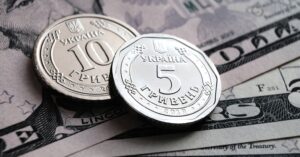
Ukraine’s real gross domestic product (GDP) grew by 5.3% in 2023 compared to the previous year, when it fell by 28.8%, according to preliminary data released by the State Statistics Service on Thursday.
According to the data, nominal GDP last year amounted to UAH 6 trillion 537.8 billion, with a change in the deflator of 18.5%.
The State Statistics Service clarified that in the first quarter of 2023, the decline in real GDP compared to the same period last year amounted to 10.3% of GDP, after which it grew by 19.2% in the second quarter, 9.6% in the third and 4.7% in the fourth.
Earlier, in December last year, the statistical agency estimated a 10.5% decline in the first quarter, followed by a 19.5% increase in the second and a 9.3% increase in the third.
Nominal GDP in the fourth quarter amounted to UAH 1 trillion 933.0 billion, compared to UAH 1 trillion 778.4 billion in the third quarter, UAH 1 trillion 463.9 billion in the second quarter and UAH 1 trillion 362.5 billion in the first quarter, according to the State Statistics Service.
As reported, in January, the National Bank of Ukraine estimated the country’s GDP growth in 2023 at 5.7%, and its nominal value at UAH 6.51 trillion. The NBU maintained its GDP growth forecast for 2024 at 3.6% (nominal UAH 7.58 trillion), slightly downgrading it for 2025 from 6.0% to 5.8%. At the same time, for the first quarter of this year, the NBU improved its GDP growth forecast to 7.1% from 5.4%, expecting it to slow to 4.8% in the second quarter.
When approving the draft state budget for the second reading in early November 2023, the government improved its estimate of GDP growth last year from 2.8% to 5%, but downgraded it for 2024 from 5% to 4.6%. According to the Ministry of Economy, GDP growth in January-February this year was 3.6%.
In its updated EFF program with Ukraine, the IMF estimated real GDP growth in 2023 at 5% and nominal GDP at UAH 6.5 trillion. It forecasts a slowdown to 3-4% this year, and an increase in nominal GDP to UAH 7.75 trillion.
For more details on macroeconomic indicators of Ukraine and the world, please see one of the video analyzes of the Experts club think tank – https://youtu.be/w5fF_GYyrIc?si=Ymo-FlMFNGfLLdK-
You can subscribe to the channel here: https://www.youtube.com/@ExpertsClub

Ukraine’s Debt Sustainability Analysis (DSA), conducted by the International Monetary Fund (IMF) as part of the third review of the EFF Extended Fund Facility (EFF), provides for a partial debt write-off to achieve such sustainability, so it is likely that such a write-off will be one of the points of Ukraine’s expected soon proposal to restructure its Eurobonds, analysts interviewed by Interfax-Ukraine believe.
“The IMF sees our public debt as sustainable with a debt/GDP ratio of 82% in 2028. At the same time, the IMF predicts that without restructuring, Ukraine’s public debt will grow to 91.2% of GDP in 2028, which means that to achieve sustainability, Ukraine should reduce this debt by 9.2% of GDP, or about $21 billion,” said Oleksandr Parashchiy, head of research at Concorde Capital.
“From this we can conclude that the IMF sees the potential to write off the state debt this year by about $15 billion. This is a very large amount, given that the main object of such a write-off should be Eurobonds, the total amount of which is $21.2 billion,” he said in a comment to Interfax-Ukraine on Thursday.
ICU Group financial analyst Mykhailo Demkiv believes that the memorandum is vaguely written, that it is impossible to clearly define the parameters of the restructuring, and everyone can see what they want there, but the market is expecting the debt to be written off, “except for some super-confident people.”
According to him, the IMF may be deliberately giving the Ministry of Finance a kind of backlash in the negotiations so as not to bind it too much and put it in a worse position.
“Optimists expect 30-40% (of write-offs), pessimists expect 40-50-75%. Personally, I expect that there will be a write-off, I am guided by 40%,” the expert told the agency. According to him, proposals to write off 70-75% contradict the statements of the Ministry of Finance about plans to return to the market.
Demkiv added that he does not expect the Ministry of Finance to make payments on Eurobonds (repayment + interest payment) until 2027, although there are optimists who see room for this in the DSA.
“As for the warrants, I don’t know if they will be included in the restructuring perimeter. There have been reports that investors want to block the restructuring of the guaranteed debt (of Ukrenergo) so that these securities are not included in the perimeter,” the ICU Group analyst also noted.
According to Paraschiy, it is right that the IMF excluded debts to Russia in the amount of about $3.6 billion (principal) to analyze Ukraine’s debt sustainability, because it is obvious to everyone that Ukraine will not repay or service them.
“What I see as the problem with the IMF’s calculation (not worrying about the 82% in 2028) is the calculation of the public debt for 2028. If we calculate all of Ukraine’s debt receipts, which the IMF itself predicts, and take into account all exchange rate differences, it turns out that Ukraine’s public and guaranteed debt at the end of 2028 will be approximately 87.3% of GDP,” added the head of Concorde Capital’s analytical department.
He explained that according to these calculations, Ukraine will need to reduce its debt by less than $9 billion (or about $6.4 billion this year) rather than $21 billion to reach the ratio of 82% of debt to GDP in 2028.
“That is, the difference/error in the forecast is quite significant for the amount of potential write-off – more than twice. It is not clear how the IMF explains this difference, except that it has planned some contingent liabilities and “other” for the equivalent of 4.3% of GDP,” Parashchiy said.
According to Demkiv, the positive reaction of Ukrainian Eurobond holders to the publication of the updated memorandum with the IMF, which resulted in a 10% rise in the cost of the securities, up to 30-38 cents per dollar, is due to the IMF’s improvement of its assessment of Ukraine’s debt at the end of last year from 87.1% of GDP to 82.9% of GDP.
“If the value of the debt improves, then less needs to be written off. And another point that some have noted is that the wording on the debt-to-GDP parameter has become a little softer: from “must” to recommended,” the ICU analyst explained, adding that such a positive reaction could also be influenced by the allocation of EU funds and improved prospects for receiving funds from the United States in April.
As reported, the IMF in an updated memorandum on the results of the third review of the program with Ukraine noted that “a decisive restoration of debt sustainability and maintenance of adequate international reserves will require a fairly deep debt adjustment.” The Fund added that even with such a “deep adjustment,” restoring debt sustainability would also require substantial fiscal adjustment and exceptional donor financing.
The documents do not explicitly mention the desirability of partial debt relief, but the IMF states that the public debt should be reduced to 82% of GDP by 2028 and to 65% of GDP in 2033, while under the baseline scenario it will be higher by almost 9 percentage points and almost 6 percentage points, respectively, in these years.
The restructuring goals also state that gross financing needs should average 8% of GDP in the post-program period (2028-2033).
In addition to reducing the debt to 82% of GDP by 2028, the restructuring also aims to ease the debt service flow on external obligations to 1-1.8% of GDP (from $1.9 billion in 2024 to $3.5 billion in 2027).
According to the third review, the Ukrainian authorities and their debt advisors are finalizing technical work to design a debt operation that meets the objectives of the debt sustainability program. They plan to present initial proposals to creditors in the near future, in line with their intention to complete the restructuring by mid-year and before the debt moratorium expires in August 2024.
“As part of the treatment of external commercial debt, which we plan to complete by mid-2024, we will strive to obtain adequate debt relief, including from the restructuring of external commercial debt, in 2024 and beyond in accordance with the program parameters,” the Ukrainian authorities said in an updated memorandum on financial and economic policy.
As reported, on the eve of the IMF’s approval in late March 2023 of a new four-year, $15.6 billion EFF program for Ukraine, the Group of Official Creditors of Ukraine (the Paris Club) provided financial guarantees for this program following a meeting with representatives of the IMF and the WB. They provide for the extension of the standstill on Ukraine’s debt payments to the Group’s countries for the period of its validity (2023-2027). The condition for such a postponement is similar actions on the part of Ukraine’s private external creditors, mainly Eurobond holders.
Recently, Reuters reported that foreign holders of Ukraine’s Eurobonds are negotiating the formation of a creditors’ committee to conduct a restructuring dialogue that could begin on the eve of the IMF’s spring meeting scheduled to begin on April 17 in Washington.

Dry, warm weather is forecast for April 1 in Ukraine. According to the Ukrainian Hydrometeorological Center, there was precipitation on Monday. The wind is mostly southerly, 7-12 m/s, in the Carpathians, during the day and in the western regions, gusts of 17-22 m/s in some places.
The temperature at night will be 5-10° Celsius, in the western regions 9-14°, during the day 19-24°, in the highlands of the Carpathians and the coast 14-19°.
No precipitation in Kyiv on Monday, April 1. South wind, 7-12 m/s. The temperature will be 8-10° Celsius at night and 21-23° Celsius during the day.
According to the Borys Sreznevsky Central Geophysical Observatory. On April 1, the highest daytime temperature in Kyiv was 20.3 in 2016, and the lowest nighttime temperature was -8.7 in 1931.
On Tuesday, April 2, there will be no precipitation in Ukraine, only at night in the Carpathians and Transcarpathia, during the day in the western and some northern regions there will be short-term rains, some thunderstorms.
South wind with a shift to the west, 7-12 m / s, at night in the Carpathians, during the day in Ukraine, in some places gusts of 15-20 m / s, in the highlands of the Carpathians 25-30 m / s.
The temperature will be 9-14° at night, 19-24° during the day, in the western regions and on the coast in some places 11-16°.
In Kyiv on Tuesday, April 2, partly cloudy weather, without significant precipitation. South wind with a shift to the west, 7-12 m / s, gusts of 15-18 m / s during the day. The temperature at night will be 12-14°, during the day 21-23°.

Starting March 31, Bulgaria and Romania will become members of the Schengen area: Schengen rules will be applied in both member states, including the issuance of Schengen visas, and control at internal air and sea borders will be abolished.
This was reported by the press service of the European Commission on Saturday.
“The Commission strongly welcomes this achievement, which follows the historic Council decision of December 2023. The accession of these two Member States to the Schengen area will make the common area more attractive by significantly expanding the world’s largest common area without internal border controls,” the press release says.
Commenting on the event, President of the European Commission Ursula von der Leyen said: “Tomorrow marks an important day: Bulgaria and Romania join the Schengen family. I welcome the abolition of internal air and sea border checks. This is a great success for both countries. And a historic moment for the Schengen area – the largest free movement area in the world. Together we are building a stronger and more united Europe for all our citizens.”

According to preliminary data, Eurocar JSC (Solomonovo, Zakarpattia region), which produces Skoda cars and is part of the Atoll Holding group of companies, ended 2023 with a net profit of UAH 37.25 million, which is almost 2.2 times less than in 2022.
According to the announcement of the annual shareholders’ meeting on April 30, as a result, retained earnings as of the beginning of 2024 increased by 16.5% to UAH 262.95 million.
The shareholders plan to use the net profit, as in the previous year, to replenish working capital, and not to accrue or pay dividends.
According to the publication, last year Eurocar increased its current liabilities by 85.4% to UAH 290.21 million, while its long-term liabilities increased slightly (by 3.2%) to UAH 1 billion 460 million.
Total accounts receivable amounted to UAH 707 million, down 22.7% over the year, while assets increased by 10.5% to UAH 2 billion 278 million due to a 2.5-fold increase in inventories to UAH 767.12 million and a 19.2% increase in cash to UAH 82.05 million.
“Eurocar has been producing passenger cars since December 2001. In June 2022, the plant resumed large-scale assembly (SKD) of Škoda cars, which was stopped with the start of Russia’s military aggression in Ukraine, but does not publish production statistics.
According to Auto-Consulting, in 2023, as in the previous year, Skoda cars took the fourth place in the rating of new passenger car sales in Ukraine, with an increase of 74.7% to 4.95 thousand units, while the market share increased to 7.61% compared to 7.08%.
According to the NSSMC, as of the third quarter of 2022, more than 68.84% of Eurocar’s shares are owned by Atoll Holding, whose beneficial owner is Oleg Boyarin, another 20% is owned by Prostir Capital LLC, and 10% by Iberia Motor Company of Poland.
According to Clarity-project, in 2023, the plant increased its net income by 73.6% year-on-year to UAH 4 billion 226 million.

In 2023, Pivdenkoks (Kamianske, Dnipropetrovska oblast) reduced its net loss by 95.2% year-on-year to UAH 58 million 25.2 thousand.
According to the agenda of the annual meeting of shareholders, which will be held remotely, voting will begin on April 12 this year and end on April 30.
The shareholders intend to summarize the results of work in 2023 and approve the reports, as well as agree to repay the loss for the year at the expense of future periods’ profits.
In addition, the shareholders will approve significant transactions made in 2021-2023, as well as preliminary approve transactions for a year from the date of their approval, i.e. for 2024 and early 2025.
The meeting will decide on the sale of the company’s own shares, which were bought back from shareholders or acquired in any other way.
As reported, Pivdenkoks ended 2022 with a net loss of UAH 1 billion 206.942 million, while in 2021 it made a net profit of UAH 1 billion 292.672 million.
According to the third quarter of 2023, Dashuria Ltd. (Cyprus) owns 94.9565% of the company’s shares.
Metinvest B.V. (Netherlands) reported in its 2018 report that the company acquired a 23.71% stake in Pivdenkoks for $30 million.
The authorized capital of Pivdenkoks is UAH 171.918 million, with a share price of UAH 0.25.